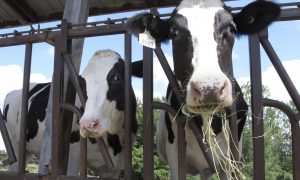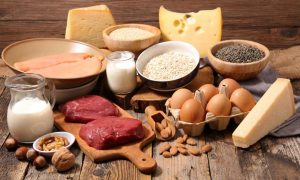
Rep. Elise Stefanik, the third-ranking House Republican, criticized the Biden administration when proposed changes to a federal food program for women and children became public.
“The Biden Administration’s proposal to restrict the amount of milk available to WIC participants is wrong,” Stefanik said in a news release.
Stefanik represents a geographically large district in New York’s North Country, and many of the state’s nearly 3,600 dairy farms are in her district.
She called the proposed changes “deeply flawed” and said that the administration “is shamefully further restricting milk choice for families and keeping the door open for more forced vegan juice consumption. Upstate dairy farmers work hard to provide delicious and nutritious products for families in New York and across the nation, and this proposed rule is a slap in the face to their important work.”
Stefanik frequently finds fault with the Biden administration, and we wondered if her claim over milk was correct.
The Special Supplemental Nutrition Program for Women, Infants, and Children, or WIC, provides healthy foods, nutrition education, breastfeeding support and referrals to health care providers and social services for low-income women, infants and children up until their 5th birthday. In 2020, the program served about 7 million people. Nutrition assistance is provided in packages specific to each population the program serves: pregnant women, postpartum women, infants, children, etc.
The proposed changes to the program reflect both updated dietary guidelines, published in 2020, and a 2017 report from the National Academies of Sciences, Engineering and Medicine, a nongovernmental group of leading experts that provides independent analysis and evidence-based advice.
The changes were detailed in the Federal Register. The proposal calls for reducing the amount of milk provided in all child, pregnant and breastfeeding participant food packages. The amount for postpartum women would remain unchanged.
Compared to current maximum monthly allowances for milk, children, depending on age, would receive 2 to 4 fewer quarts per month. Pregnant and mostly breastfeeding participants would receive 6 fewer quarts per month, while fully breastfeeding participants would receive 8 fewer quarts per month. The proposed rule also calls for a new package specifically for 1-year-olds, who are grouped with older children under the current rules. Under the new guidelines, 1-year-olds would get less than children ages 2 to 4.
The reason for the changes, according to the U.S. Department of Agriculture, which administers the WIC program through its Food and Nutrition Service, is that the current program provides amounts up to 128% of the daily recommended amount of dairy. The National Academies advised the amount of milk allowed in the program should be reduced to between 71% and 96% of the recommended amount.
The proposed quantities are consistent with nutrition guidelines to consume a balanced diet that meets, but does not exceed, recommended amounts of food and nutrients, to prevent obesity and to not displace other healthy foods, according to the Federal Register notice.
The change is “modest,” and represents just a 3% reduction in WIC spending on milk and milk alternatives, USDA Press Secretary Marissa Perry told PolitiFact.
“WIC’s food packages are designed to be supplemental, filling specific nutritional gaps, building on what participants already consume to provide a balanced and nutritious diet,” Perry said. The reduction allows the packages to provide a better balance of food and nutrition, she said.
Shannon E. Whaley was vice chair of the National Academies committee that published recommendations for proposed changes and is also director of research and evaluation at the nonprofit Public Health Foundation Enterprise WIC Program. Whaley emphasized the supplemental nature of the program, and added the amount of milk that participants were purchasing through the program was less than what was allotted. “Therefore, the report recommends a small calibration of the amount of milk issued, but at a level still above the average amount redeemed,” Whaley said.
We asked Stefanik’s office about her claim that the recommendations open the door to more “forced vegan juice consumption.”
“As it says in the proposed rule, the USDA is keeping the door open to the availability of other plant-based beverages (e.g., oat, almond),” said Stefanik’s spokesperson Palmer Brigham. “Coupled with proposing restricting milk, this shows the move towards more vegan juice consumption.”
A WIC researcher at the Johns Hopkins Bloomberg School of Public Health, Susan Gross, said that WIC program participants have diverse needs, such as food allergies or being vegan, and they do not drink milk from cows. Program administrators want to explore whether other alternatives can be offered. Lactose-free milk and soy milk have always been part of the program, but other milk alternatives, such as almond milk, are not, because they do not have enough nutrients to meet USDA standards, said Gross, who is an associate scientist in the Department of Population, Family and Reproductive Health and a WIC program nutritionist.
The WIC packages are tailored for each participant, and participants can choose what type of milk they want. “No one is forced to drink milk alternatives,” Gross said.
The USDA is accepting public comments on the proposed changes until Feb. 21, 2023.
Stefanik claimed that a proposed rule would limit milk for participants of a federal food program for women and children.
The USDA has proposed changes to the program, which includes reductions in the amount of fluid milk available to most program recipients, prompted by new dietary guidelines as well as recommendations from the National Academies of Science, Engineering, and Medicine. The reductions are also in line with what WIC recipients purchase through the program.
Stefanik also made a prediction that the proposed rule would lead to more “forced vegan juice consumption.” We don’t fact-check predictions and that statement is outside the scope of this ruling. It should be noted, however, that based on the available evidence, WIC has not and will not force milk alternatives on anyone.
We rate this claim True.





















